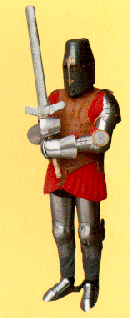Meet the Middle Ages
BackThe armour of a knight

During the 14h and 15th centuries, the armour of a knight was clumsy and heavy. The body was totally covered in sheet-metal in order to give protection against arrows and sword-blows. The suit of armour weighed around 35 kilos. The knight himself had to be strong and fit to be able to carry such a weight. An armour with all its parts was very expensive to make.
The knight wore a jacket closest to his skin, as a kind of padding, so that the blows would be softened. On top of the jacket he might wear a so-called Visby armour, a leather jacket covered in sheet-metal. This armour allowed some movement. Towards the end of the 14th century so-called cuirasses came into use. These were large sheets of metal which covered both breast and back. The cuirasses were heavier and stiffer than the Visby armour, but it gave better protection. Arms and legs were covered with strips of metal. There were strips on the upper arms, forearms, thighs and calves. On his feet, the knight wore sheet-metal shoes. The helmet could be barrel-shaped, with slits which enabled him to see. It might have been difficult to breathe inside the helmet. Some knights used helmets with visors which could be opened in front of the eyes and the mouth. Then breathing was made easier. A special neck cover was used by many knights to protect the neck. The knight also wore metal gloves.
When in battle, the knight was on horse. If he were on ground, he would be an easy target for the soldiers with their long pikes. The horse could be covered in metal sheets as well. The knight was armed with a sword, with a shield for his protection. In the beginning of the 15th century, many knights stopped using shields, because they were too heavy.
In the heat of the battle it might have been difficult to see who was the friend and who was the enemy. Therefore, the knight wore a sign or an adornment on his helmet. Sometimes he wore a piece of clothing on top of his armour, a long sur-coat or a short tabard, to show who he was. As a sign of his identity, his coat-of-arms was painted on his shield.
It was very expensive to make and to repair an armour. The sheet-metal had to be properly looked after, repaired and polished. Only the wealthiest noblemen could afford an armour.